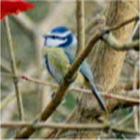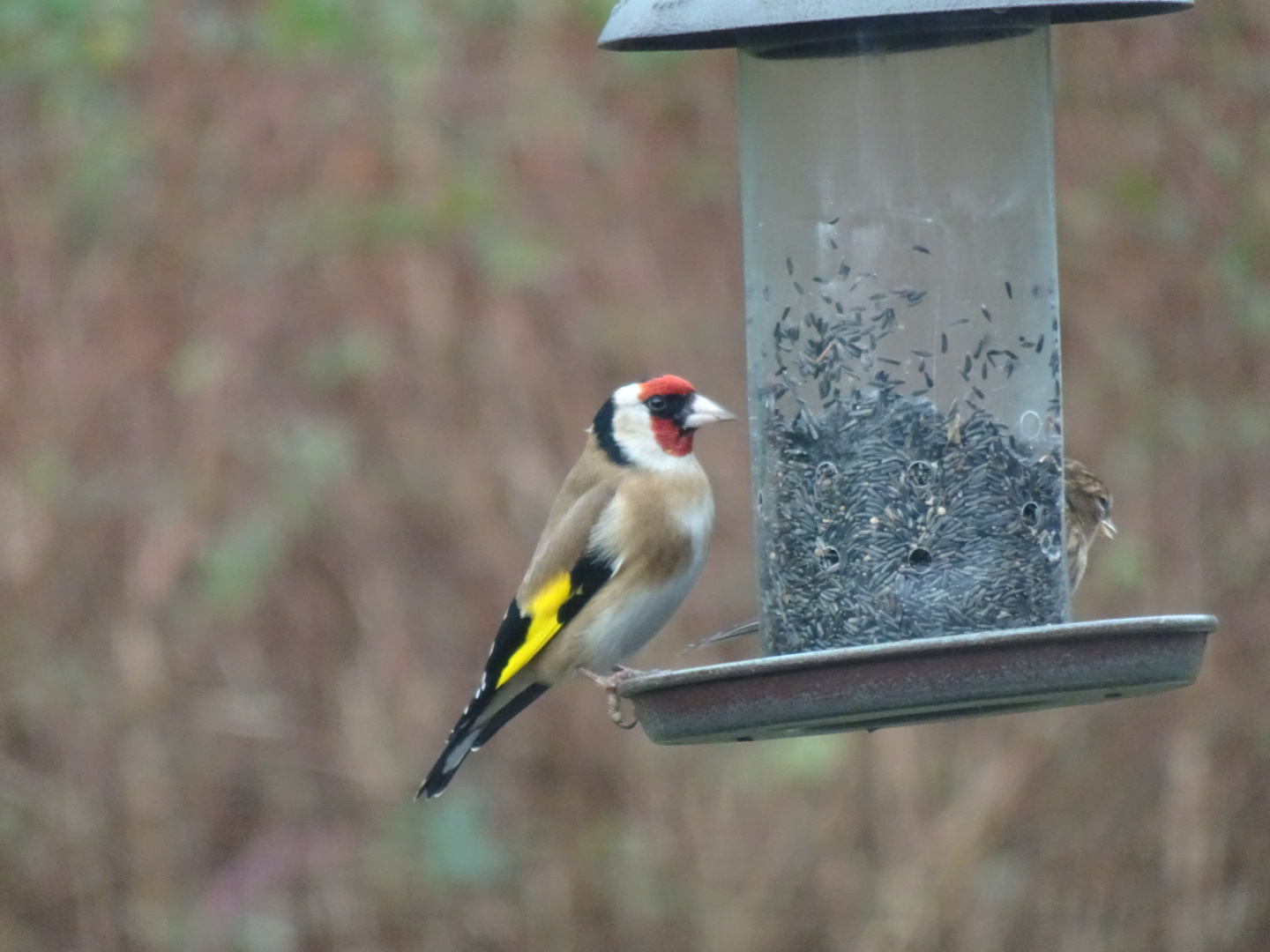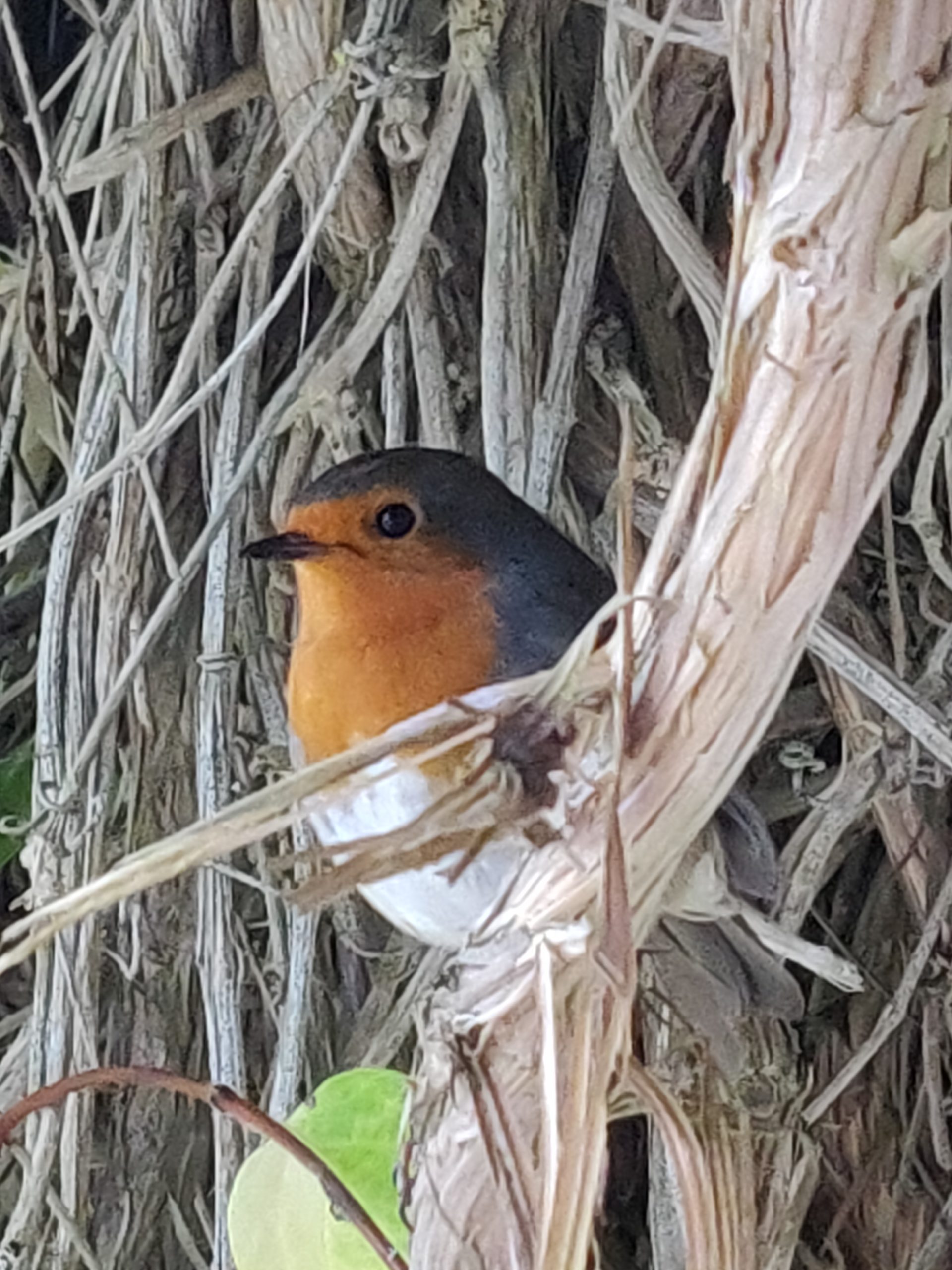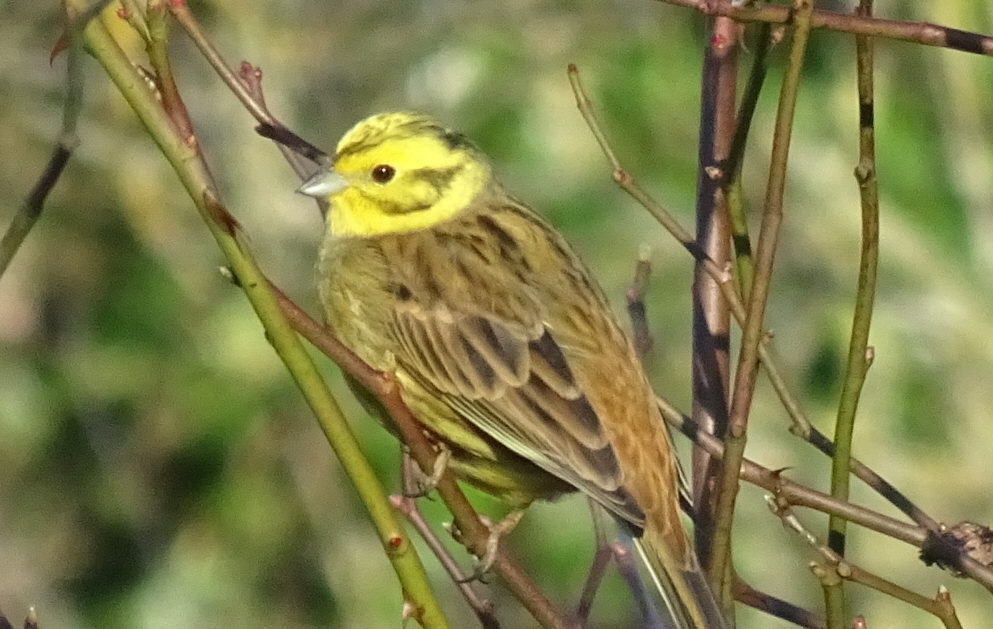Birds | Butterflies | Insects | Mammals
The greater the variety of trees and plants in and around a hedge then the greater the variety of birds that you will likely find in a hedgerow.
In Ireland you will find native birds, birds thqat live here all year round. You will also find birds that migrate to Ireland at different times of the year.
Here you will find an alphabetical list of many of the birds that you might commonly find in Irish hedgerows.
Blackbird

About the Blackbird:
Blackbirds are 25cm in length. Male Blackbirds are jet-black with a bright yellow beak and eye-ring. Female Blackbirds have a brown plumage and a brown beak. They range across Europe including Ireland. They eat insects and worms, as well as feeding on berries and fruit. They have a loud and warbling flute-like song and a noisy chatter when disturbed. Blackbirds use a variety of nest sites including trees, bushes, hedges and buildings, or may even be seen nesting directly on the ground.
Blue Tit

About the Blue Tit:
Blue Tits have yellow underparts with blue wings, a blue tail and a blue cap. Adults have white cheeks, but those of the young are yellow. When they are excited, they raise the short crest on their nape. They range throughout Europe and are widespread in Ireland and the UK. Blue Tits live in deciduous woodland, parks, gardens and farmland hedges. They feed on small insects, spiders, fruits, seeds and nectar. The nest is cup-shaped and made of moss and grass and lined with hair, feathers and wool, positioned in a hole in a tree, bush, hedge or wall.
Bullfinch

About the Bullfinch:
Male Bullfinch’s have a black cap, black wings and tail, a white rump and wingbars, and a red breast. The female Bullfinch does not have the red breast and she is brownish-pink with a brown mantle. Bullfinches stretch from Ireland to the southern Mediterranean regions Their are usually found in coniferous forest, woodland, parks, gardens and cultivated land. They feed on buds, seeds and fruit. Bullfinches are shy birds and do not often land on the ground. They have a low whistling call as well as a quiet piping song. The female builds the very twiggy cup-shaped nest of twigs and moss in a bush or hedge.
Chaffinch

About the Chaffinch:
The male Chaffinch have a slate-blue head and a wine-coloured breast and the female Chaffinch has yellow-brown plumage. Chaffinches range from Ireland through Europe, the Mediterranean region and North Africa. They are often found in woods, orchards, parks, gardens and fields with hedgerows. They mostly feed on seeds, fruit and corn, but need insect larvae for their chicks. Their call-note is a cheerful song that varies in dialect according to its region. Their nest is neat and strong and positioned in a tree or a bush close to the trunk or a firm branch.
Chiffchaff Warbler

About the Chiffchaff Warbler:
The Chiffchaff Warbler is a lively bird that feeds on insects in trees and bushes. Apart from breeding time it seems to be playfully quarrelsome as it constantly chases away other birds. The Chiffchaff Warbler has a distinctive song, a repeated monotonous “chiff-chaff” or “zip-zap”, sometimes interspersed with a guttural “chirr-chirr”. The female bird chooses the place for the nest and builds it alone. The male bird keeps watch of the female, sings and defends the territory. The nest is ball-shaped, closed at the top and opening for flying in and out on one side.
Coal Tit

About the Coal Tit:
Irish Coal Tits are easily recognised by the strong deep yellow tones on the cheeks, breast and belly. They are olive-grey above, with a glossy black head and bib and they have two faint wingbars. They often live in coniferous woodland and especially near spruce trees. They are frequently seen in parks and gardens, especially during winter. Coal Tits like to eat larval insects and spiders, often found in conifer branches, needles, and bark. They will hang upside down in trees, bushes and hedges,etc. to extract insects or seeds. Their favourite song is a high-pitched, repetitive ‘wheat-see, wheat-see’.
Dunnock

About the Dunnock:
The Dunnock has a grey body with reddish brown streaks, a deep brown upper mantle streaked black with a grey throat and chest. They have a fine pointed black bill for catching insects such as beetles, spiders, flies, aphids, ants and worms. Some small fruits and seeds are also eaten. In Ireland, Dunnocks are said to have a variety of breeding patterns which include simple pairs, a cock with several hens, or a hen with several cocks. The hen builds a well concealed nest in a hedge or in thick undergrowth very close to the ground. The nest is a neat bowl of twigs, grass and moss lined with hair, feathers and moss.
Goldcrest

About the Goldcrest:
The Goldcrest is a small greenish bird with a partially concealed black-edged crown stripe, yellowish in the female, golden in the male. At about 6 g in weight, they are the smallest bird in Ireland. They build their nests high up in trees, most often in conifers or on the ivy-covered trunks of hardwoods. These birds are constantly active, flitting about picking food from the underside of leaves. Their diet is made up of insects, spiders and their larvae. The male and female build the cup-shaped nest together using cobwebs and moss. The nest is then suspended below an outer branch and lined with feathers.
Goldfinch

About the Goldfinch:
The Goldfinch is the most striking of the finches we have here in Ireland. They have black wings with gold bars and the adult birds have a brilliant red face. Their crown is black with white around the ears and sides of the neck. When feeding they are so harmonious with their surroundings it is not easy to detect them. They are particularly fond of the seeds of plants such as the winged and Scotch thistle. The male bird song is a pleasant liquid twittering. They are not very territorial birds, usually only defending the area around their nest. It is the female Goldfinch who builds the nest.
Great Tit

About the Great Tit:
The Great Tit has a black crown and a white cheek patch, with a black bib down it’s body center. They range from Ireland through Europe and beyond. They inhabit forests, woods and hedgerows in farmland. They are also found in parks and gardens with afluent greens. They forage in trees and on the ground, feeding on insects, spiders, seeds, buds, nuts and fruit. Great Tits have a wide variety of loud calls including a distinctive ‘teacher, teacher’ song. The nest is built by both adults and is made of moss and grass, and lined with hair and feathers. This is positioned in a hole in a tree or a wall.
Greenfinch

About the Greenfinch:
The Greenfinch has olive-green feathers and a green-yellow rump, a large and pinkish beak and pink legs. The female is duller and less yellow than the male. The Greenfinch is very common in Ireland and is present in gardens, parks, alleys lined with trees and forests of conifers. They feed on the ground, pick grains or devour buds on trees and shrubs but may also capture a few insects to feed their young. Their nest is made of moss, dry stems, roots, hairs, feathers; often built in evergreen or bushy plants. This species gathers into large flocks in autumn and during the winter months these groups wander in cultivated fields in search of food.
House Sparrow

About the House Sparrow:
House Sparrows are found almost always near areas of human habitation and distribution such as cities and suburbs or areas with a reliable food source like barns or granaries. This species nests in structures ranging from gutters and downpipes to thick shrubs and bushes. They effectively compete with other local birds, and are known to destroy nests and eggs and kill nestlings and adults while taking over a nest site. The male constructs a bulky, dome-shaped nest of coarse grasses, weeds, hair and feathers. The female lays three to five white/brown speckled eggs.
Linnet

About the Linnet:
Linnets are social birds throughout the year and twitter constantly to each other. By staying together in small groups they search for food and watch out for predators at the same time. The linnet is a common species across the Irish countryside where it favours weedy fields, hedgerows, woodland edges and orchards. Linnets are also very dependent on wildflower seeds during the breeding season, when the chicks are fed on seeds rather than insects. In winter they form large flocks and feed on stubble fields and other cultivated areas, along shorelines and on waste ground.
Reed Bunting

About the Reed Bunting:
As the name suggests, Reed Buntings prefer marshy areas with reeds, sedges and scrub. Reed Buntings feed on the ground and they like to stay close to low cover in damp thickets and overgrown bushy meadows. These areas provide valuable food such as insects and seeding weeds. They often feed in grassland close to waterside vegetation and during the winter months can be seen on farmlands far from water. In some countries, e.g. in Ireland, the Reed Bunting has adapted to drier habitats including heathland, hedges and young conifer plantations.
Robin

About the Robin:
Robins are resourceful birds and almost anywhere will do to nest !
Robins are aggressive defenders of their territories. In the breeding season, between March and June, males use their red feathers to warn off rivals, puffing out their breasts and make loud ticking calls. Young Robins are streaked and speckled and have no trace of red. Robins will often sing at night under street-lamps and are sometimes mistaken for nightingales. Unlike most other songbirds, both male and female robins sing. Robins have different songs in spring and autumn.
Song Thrush

About the Song Thrush:
The Song Thrush is a popular bird both for its handsome colouration and attractive, complicated song patterns. It is usual for one thrush to have over 100 different song phrases. The Song Thrush eats a variety of slugs and snails. The song thrush can produce between 1-3 broods of chicks each summer. Signs of the Song Thrush include the presence of ‘anvils’ or stones which the birds use to crack open shells, often found surrounded by the remains of smashed snail shells.
Tree Sparrow

About the Tree Sparrow:
Tree Sparrows are widespread in Ireland but they are decidedly scarce from the local population! Occasionally they are found on the outskirts of villages but more often they are associated with untidy arable farms, taking advantage of frequent grain spills. The sexes are similar with a chestnut cap and nape, a black patch on white cheeks and a plumage streaked brown on their back with pale underparts. They utter sparrow-like chirps but also a sharp tik tik in flight. Tree Sparrows form flocks during the winter months and sometimes they feed in stubble fields.
Willow Warbler

About the Willow Warbler:
These small, fairly quiet songbirds live in trees and bushes through the spring and summer months. They are very common in rural gardens, where they feed on insects and spiders. Willow Warblers are also found in willow and birch scrub. Willow warblers make their nests from grass lined with feathers, usually on the ground among vegetation or small bushes. They generally produce six to eight eggs, which are white with light red spots. The Willow Warbler sings a song of descending notes, often repeated.
Wren

About the Wren:
Wrens are birds of the undergrowth, be it dense woodland shrubbery or coastal bramble patches. In spite of its cute appearance, cocked-up tail, perpetual motion and constant chatter, the wren is still considered a villain by some folks. The males often vandalize the nests of other hole-nesting species within their territories, puncturing the eggs or even throwing the young from the nest. They usually lay 5-8 white eggs, thickly speckled with brown, laid in a nest of twigs lined with feathers and other soft materials. Wrens are present throughout the year.
Yellow Hammer

About the Yellow Hammer:
The Yellow Hammer is a member of a species, also found in Ireland, of the Yellow Bunting. These birds are about sixteen centimeres long, their general colouring mottled brown above and yellow below, the head being yellow, streaked with brown, and the rump and tail coverts chestnut. Their food is chiefly insects and fruits, especially blackberries in autumn. Their nest is often placed upon the ground and contains four or five eggs.
